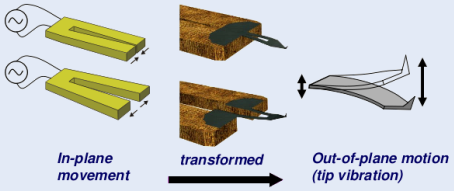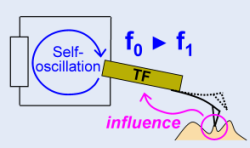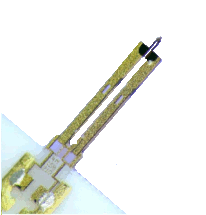Related information
 A-Probe Guide
A-Probe GuideWhat is A-Probe?
How it works?
What can be done?
 Technical Guide
Technical GuideElectrical setup
Amplifier, Settings
Operations

The quartz tuning fork (TF) is electrically excited at its lowest resonance. In this mode, the ends of the two prongs are moving in-plane and have opposite phases, meaning that they approach and withdraw from each other. The vibration amplitude is typically in the order of tens of nm. This motion applies a small vibration at the glued ends of the cantilever, which always contains a component in z-direction (i.e., the axis of the tip) due to the twisting motion of the prongs (i.e., the cantilever disturbs the symmetry of the TF). The cantilever amplifies the vibration according to its mechanical property and a large out-of-plane motion of the tip is obtained.

The TF is used as an oscillatory force sensor similarly to a quartz microbalance. Its frequency and amplitude are influenced by those of the tip motion. Consequently, the tip-sample interaction can be electrically detected with the TF. During sample imaging, the resonance frequency is tracked by a phase locked loop (PLL) and kept at a set value by adjusting the tip-sample distance with a feedback loop.
The recommended operation mode for Akiyama-Probe is dynamic mode with the frequency modulation (FM) detection (self-oscillation). The amplitude modulation (AM) detection (fixed driving frequency) is also feasible, if one would accept a slower scan speed and compromise on spatial resolution. Akiyama-Probe is designed for operation in ambient conditions. It could work in other environments, like vacuum, UHV, or low temperatures etc.
